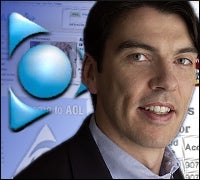 |
| Tim Armstrong, CEO of the newly independent AOL |
AOL has formally ended its rocky marriage to Time Warner, reemerging this morning as a standalone, publicly traded company positioning itself as a leader in online content, advertising and communications services.
After ringing the opening bell at the New York Stock Exchange, CEO Tim Armstrong talked up the company’s vision in a conference call with reporters.
“We’re in a good place because of where the Internet is headed,” he said.
By Armstrong’s reckoning, the history of the Internet — at least as a popular consumer medium — began in the 1990s and was defined by access. That early iteration, when people connected to the Internet through a phone line and first discovered the wonders of e-mail, turned AOL into an empire.
In the next decade, access gave way to platforms, Armstrong said, noting the rise of Google and Facebook, online hubs built around utilities like search and social networking.
So where to next?
“We believe the next wave of the Internet will really be about content,” Armstrong said.
Despite significant layoffs and a major internal reorganization, AOL employs 3,500 staff and freelance journalists who create about 80 percent of the content that appears across its sites.
Coupled with AOL’s still-substantial audience, that trove of content presents a compelling opportunity for advertisers, the company is betting.
“I don’t know of any other properties on the Internet that are producing that much content at scale,” Armstrong said.
In many ways, AOL’s strategy mirrors the vision Yahoo (NASDAQ: YHOO) CEO Carol Bartz has articulated for that other Internet pioneer that has struggled to remain a top player in the fast-evolving Web.
Both companies are doubling down on quality content, snapping up writers and editors — many taking flight from newspapers and other traditional media outlets — to build out their existing verticals and launch new ones, all in an effort to grow their audiences and court advertising dollars.
Armstrong acknowledged the similarities, particularly in regard to their focus on display advertising, though he said that AOL is making a more aggressive push into producing original content.
[cob:Special_Report]”Yahoo and AOL get compared a lot. I think that we actually have different positions at this point,” he said.
AOL argues that it is poised to become the leading Internet property catering to local audiences, a potentially lucrative ad market that has drawn considerable attention from other Web giants, including Yahoo.
AOL, for instance, maintains Patch.com, a news site with community sections offering hyper-local coverage of neighborhood issues like schools and zoning boards. Armstrong co-founded Patch while serving as Google’s head of sales.
The company has also launched Seed.com, a content management platform set up as the hub for the writing and photography assignments available for freelancers that will populate AOL’s network of sites. AOL brought on veteran technology reporter Saul Hansell to serve as programming director for Seed, after Hansell took a contract buyout from The New York Times.
Ben Schacter, an analyst with Broadpoint AmTech, gave a more somber assessment of AOL’s prospects as a standalone, expressing skepticism about the company’s ability to build loyal audiences through its content initiatives.
“If the new management team cannot fix user engagement, most of the other initiatives will not mean much,” Schacter said in a research note initiating coverage of AOL. “To that end, the company has laid out a strategy to focus on ‘niche-at-scale’ content and advertising. We are simply not believers in this strategy, and we do not give the company credit for it working.”
Schacter noted the ongoing dissipation of AOL’s Internet subscription business, which remains a profitable sector for the company, and said he expects advertising revenues to decline into 2011.
AOL slipped out of the gate, with shares down 2.3 percent in morning trading.


